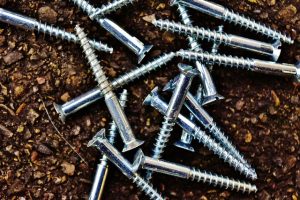
Screws are one of the world’s most common types of fasteners. Not to be confused with bolts, they are used to secure two or more surfaces together. As the screw drives through the surfaces, it “digs” out material via its external threading. Even if you’ve used screws, though, you may be unfamiliar with their various parts. While there are many different types of screws, they are all comprised of a few similar parts.
The Tip
The pointed end of a screw is known as the tip. Most screws have a sharp and pointed tip that’s able to bore a hole into surfaces. The tip is usually narrower than the rest of the screw. This allows it to penetrate otherwise hard materials. Without a tip — or with a wide tip — a screw may struggle to penetrate hard materials. The tip often changes depending on what material the screw is intended to be used on.
The Threading
Threading is the section of a screw that contains helical ridges. Screws rely on this threading to remove material from the surfaces into which they are driven. The threading essentially scoops out material as the screw is driven into a surface. When a screw is driven into a surface, it will displace some of the surface’s material. The material will enter the helical ridges where it travels up and out of the surface.
The Shank
Screws also have a shank. For wood screws, the shank is the unthreaded portion that’s found above the threaded portion. Wood screws have an unthreaded shank to create a stronger and more secure hold. With only part of a wood screw being threaded, it offers a stronger hold than that of traditional screws with complete threading from top to bottom. Other types of screws have a fully threaded shank, meaning the threading extends all the way from the head to the tip. Wood screws are different because they almost always have an unthreaded shank.
The Head
Finally, the head is the top section of a screw. There are two types of screw heads: traditional and counter-sunk. Counter-sunk heads are intended to rest flush with the surface into which they are driven. In comparison, traditional screw heads protrude out of the surface into which they are driven. Both traditional and counter-sunk screw heads feature one or more notches, which are designed to support the use of a screwdriver. To drive a screw into a surface, you must press the screwdriver into these notches, after which you can turn the screwdriver.
The Drive
When people ask “Flat head of Philips head?”, they are actually referring to the type of drive not the head of the screw. The drive is a crucial component of the screw as it determines what type of screwdriver needs to be used to install the screw.
In Conclusion
In addition to these main parts, some screws may also having additional features depending on the screw type and it’s application. The most common additional feature is a washer, standard or locking. The washer provides a better seal and distributes the load more evenly across a larger surface. In conclusion every part of a screw is integral and can change depending on what type of screw you are using. Understanding each component and the difference
